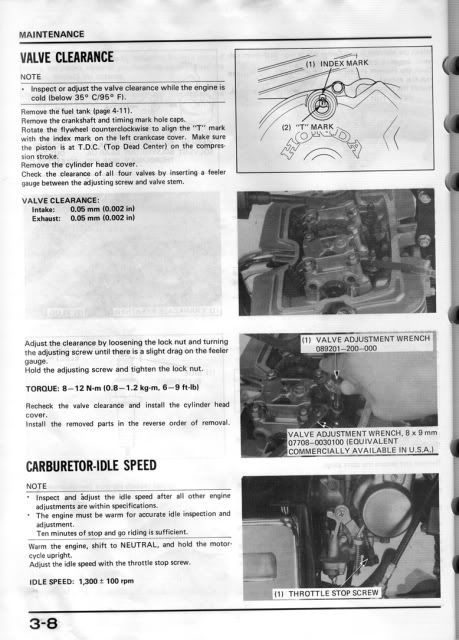10/05/2018 This post has been edited to show the simple procedure below, first described by Duckster.
Remove the two front tank bolts and place a 2”X4” under it to allow clearance for removing the valve cover. Pull the spark plugs so the engine will turn over easily, and put the bike in 5th gear so you can use the rear wheel to roll the engine over. Raise the rear wheel (swingarm lift, blocks under the frame, etc.). Now you can check valve clearances quickly without being concerned about the timing marks on the crankshaft by taking advantage of the Rebel's overhead camshaft and 360 degree crankshaft arrangement.
If you don't have a stand, it isn’t essential; you can still roll the bike back and forth as needed to rotate the engine. Just pull in the clutch to roll the bike backward without turning the engine. Always roll the bike forward to turn over the engine.
Once you have the valve cover off, roll the engine over until the left exhaust valve starts to open (rocker arm goes down). Then roll it very slowly until the rocker arm is all the way down. Don't worry if it starts back up again, that's good enough.
At this point the left exhaust valve is fully open. Now check the clearance on the right exhaust valve. It is in the middle of the cam "base circle" and your clearance check and adjustment if needed will be correct.
Repeat the procedure for the left exhaust valve, and then do the intakes in exactly the same way.
Remove the two front tank bolts and place a 2”X4” under it to allow clearance for removing the valve cover. Pull the spark plugs so the engine will turn over easily, and put the bike in 5th gear so you can use the rear wheel to roll the engine over. Raise the rear wheel (swingarm lift, blocks under the frame, etc.). Now you can check valve clearances quickly without being concerned about the timing marks on the crankshaft by taking advantage of the Rebel's overhead camshaft and 360 degree crankshaft arrangement.
If you don't have a stand, it isn’t essential; you can still roll the bike back and forth as needed to rotate the engine. Just pull in the clutch to roll the bike backward without turning the engine. Always roll the bike forward to turn over the engine.
Once you have the valve cover off, roll the engine over until the left exhaust valve starts to open (rocker arm goes down). Then roll it very slowly until the rocker arm is all the way down. Don't worry if it starts back up again, that's good enough.
At this point the left exhaust valve is fully open. Now check the clearance on the right exhaust valve. It is in the middle of the cam "base circle" and your clearance check and adjustment if needed will be correct.
Repeat the procedure for the left exhaust valve, and then do the intakes in exactly the same way.








